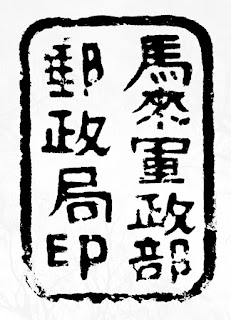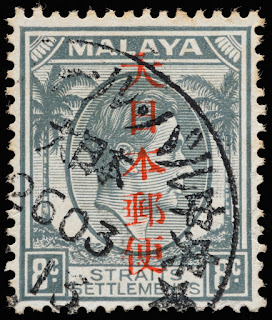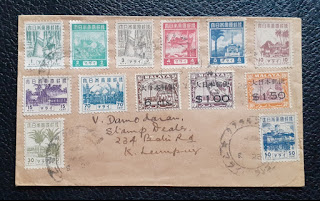(First Day Covers, stamps, leaflet and currency from personal collection)
The Pacific War, sometimes called the Asia- Pacific War, was the largest theatre of World War II, Japan used the name "Greater East Asia War", as chosen by their Cabinet in December 1941.
Map of Asia Pacific Region 1939
The Japanese occupied Malaya from February 1942 to September 1945 after landing at Kota Bharu, Kelantan on 08 December 1941. Singapore's postal services were given a high priority and were resumed a month after the surrender on 16 February 1942.The other States followed over the next few months.
First Day Cover 30 March 1942 with the defaced stamps.
Japanese calendar year 2602 stamped, correlates to 1942 of the Georgian calendar.
In ancient times, red ink was exclusive to the 'samurai'. This bears the stamp of 30 March 1942. (Japanese equivalent being 2602)
Chop II (Gunsei-bu single frame overprint) similar to Chop I but with a single rectangular frame were then used before September 1942.
The Okugawa seal, introduced in Penang on 30 March 1942. (First Day Cover)
The Okugawa seal, introduced in Penang on 30 March 1942, was the personal seal of Akira Okugawa, Chief of Treasury Section of the Penang Government.
Subsequent stamps were overprinted by machine with "Dai-Nippon-2602-PENANG" on 15 April 1942. Dai Nippon meaning Greater Japan Postage and 2602 is the Japanese equivalent of 1942 in the Georgian calendar.
Penang was used as a submarine port by the Japanese, Italian and German navies.
The PENANG overprint was succeeded by the Dai-Nippon-2602-Malaya overprint in July 1942.
To eliminate the use of English, the machine printed Kanji overprint was introduced in December 1942 and used till the end of the war. The characters translated to 'Great Japan Postal Services.'
To establish an Asian identity under the Japanese, a new stamp issue preparations began in 1942. The first postage stamp design contest was held, and five stamp designs were selected and issued as 1,2,3,4 and 8 cent stamps. It was also the first-time pictorial stamps were issued.'
A commemorate cancellation dated 8 December 2602 in Japanese calendar (December 8th, 1942) to celebrate the first anniversary of the start of the 'Great East Asia War' when Japanese troops landed at Kota Bharu, Kelantan on 08 December 1941.
Post cards were issued to commemorate the first anniversary of the fall of Singapore on 15 February 2603 or 1943 in the Georgian calendar.
Commemorate Post Card stamped 15 February 1943.
During the occupation, the Japanese replaced the Malaya dollar with their own dollar, a form of currency issued for use within the Imperial Japan occupied territories of Singapore, Malaya, North Borneo, Sarawak and Brunei between 1942 and 1945. Informally called as 'banana money' named because of the motifs of banana trees on the ten-dollar banknotes. The currency was referred to as 'dollars' and 'cents'.
One cent, Japanese Government.Fifty cents, Japanese Government.
On 15 August 1945, Emperor Hirohito gave a recorded radio address to the Empire announcing acceptance of the terms for ending the war set by the Allies. Under Operation Jurist, Penang became the first state in Malaya to be liberated from the Japanese rule. The garrison in Penang surrendered on 2 September 1945 aboard HMS Nelson.
First Day Cover of Victory stamps of Great Britain June 11th, 1946.
Following the Japanese surrender, aerial leaflets were dropped over Prisoner of war camps and in the jungles in 1945. Double sided, leaflets in English and Japanese texts. These leaflets contained instructions for prisoners of war and internees.






























No comments:
Post a Comment
Any inputs or feedback is welcome!